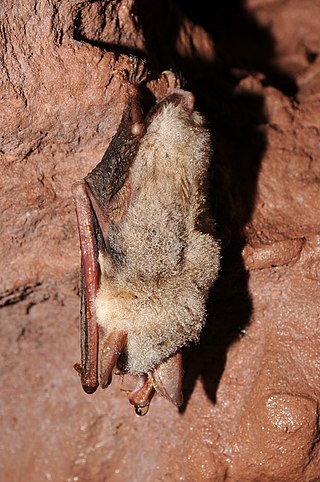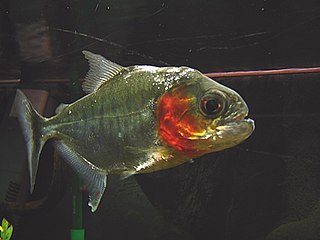
Vespertilionidae is a family of microbats, of the order Chiroptera, flying, insect-eating mammals variously described as the common, vesper, or simple nosed bats. The vespertilionid family is the most diverse and widely distributed of bat families, specialised in many forms to occupy a range of habitats and ecological circumstances, and it is frequently observed or the subject of research. The facial features of the species are often simple, as they mainly rely on vocally emitted echolocation. The tails of the species are enclosed by the lower flight membranes between the legs. Over 300 species are distributed all over the world, on every continent except Antarctica. It owes its name to the genus Vespertilio, which takes its name from a word for bat, vespertilio, derived from the Latin term vesper meaning 'evening'; they are termed "evening bats" and were once referred to as "evening birds".

Horseshoe bats are bats in the family Rhinolophidae. In addition to the single living genus, Rhinolophus, which has about 106 species, the extinct genus Palaeonycteris has been recognized. Horseshoe bats are closely related to the Old World leaf-nosed bats, family Hipposideridae, which have sometimes been included in Rhinolophidae. The horseshoe bats are divided into six subgenera and many species groups. The most recent common ancestor of all horseshoe bats lived 34–40 million years ago, though it is unclear where the geographic roots of the family are, and attempts to determine its biogeography have been indecisive. Their taxonomy is complex, as genetic evidence shows the likely existence of many cryptic species, as well as species recognized as distinct that may have little genetic divergence from previously recognized taxa. They are found in the Old World, mostly in tropical or subtropical areas, including Africa, Asia, Europe, and Oceania.

Serrasalmus is a genus of piranhas. They are collectively known as pirambebas; the "typical" piranhas like the piraya piranha are nowadays placed in Pygocentrus. Like all piranhas, Serrasalmus are native to South America.

Rousettus is a genus of Old World fruit bats or megabats, referred to as rousette bats. The genus is a member of the family Pteropodidae. The genus consists of seven species that range over most of Africa to southeast Asia, and the islands of the south Pacific. They are among the few megabats capable of echolocation, and the only genus of megabats known to use vocal echolocation.

Dekeyser's nectar bat is a bat species found in Brazil and Bolivia.

Pristobrycon is a genus of piranhas from the Orinoco and Amazon Basins, as well as rivers in the Guianas.

Francisco Mago Leccia (“Mago”) was born in Tumeremo, Bolívar State, Venezuela on May 21, 1931 and died in Puerto La Cruz, Anzoátegui State, Venezuela on February 27, 2004. Mago was a distinguished Venezuelan ichthyologist who specialized in electric fish of the rivers and lagoons of South America, particularly of Venezuela. His education was Docent in Biology and Chemistry graduate from the “Instituto Pedagógico de Caracas”,, Master of Sciences from the University of Miami, Florida, U.S.A., Doctor in Sciences from Universidad Central de Venezuela. His Doctoral Thesis was entitled: “Los peces Gymnotiformes de Venezuela: un estudio preliminar para la revisión del grupo en la América del Sur”.

Bryconops is a genus of freshwater fish in the family Iguanodectidae from South America. It consists of small fish, all under half-a-foot long, with slender bodies and silvery scales, though there is some mild color variation. Several species can be identified by way of a humeral patch, and others have a reddish ocellus, or eyespot, on one or both lobes of the dorsal fin.

Nyctophilus is a genus of the vespertilionids or vesper bats. They are often termed Australian big-eared bats or long-eared bats, as the length of their ears often greatly exceeds that of the head. This genus occurs in the New Guinean-Australian region.
Handbook of the Mammals of the World (HMW) is a book series from the publisher Lynx Edicions. The nine volumes were published from 2009 to 2019. Each mammal family is assessed in a full text introduction with photographs and each species has a text account with a distribution map and illustrations on a plate. This is the second major project by Lynx Edicions since the release of the Handbook of the Birds of the World in 1992. The chief editors are Russell Mittermeier and Don E. Wilson in association with Conservation International, the Texas A&M University and the IUCN. Don E. Wilson is also editor of the reference work Mammal Species of the World.

Tinaminyssus is a genus of mites in the family Rhinonyssidae. There are more than 60 described species in Tinaminyssus.

Spinturnicidae is a family of mites in the order Mesostigmata. The mites are highly specialized parasites of wing or tail membrane or bats. Some species infest eyelids and eye canthi. The species of Spinturnicidae are found in bat habitats throughout the world, living all stages of life on bats.
Mesoperiglischrus is a genus of mites in the family Spinturnicidae. There are at least two described species in Mesoperiglischrus, found in the Neotropics.
Periglischrus is a genus of mites in the family Spinturnicidae. There are more than 30 described species in Periglischrus, found in South, Central, and North America, and in Africa.

Spinturnix is a genus of mites in the family Spinturnicidae. Spinturnix mites are an ectoparasite found on species of bats. They live exclusively on the wing and tail membranes and are large enough to be seen with the naked eye. Spinturnix mites are a host specific species, meaning they have a few major host species that they prefer, as well as a few less frequently used hosts. In short, these mites will not infect arbitrary bat species. Their selection of host tends to align with the host species that lives closest to their local environment. Spinturnix mites are found strictly on Microchiroptera. These mites are hematophagous, meaning they feed on the blood of their host. They cannot survive without a host for more than a few hours. Therefore, transmission of mites to other hosts must occur by close contact, such as a bat in a roost.

Cornufer is a genus of frogs in the family Ceratobatrachidae. It has been greatly expanded by Brown, et al. (2015) to include most Australasian frogs in the family Ceratobatrachidae. Species are found in Melanesia and Polynesia — in Palau, Fiji, New Guinea, and in the Admiralty, Bismarck, and Solomon Islands.

Iguanodectidae is a family of freshwater fish in the order Characiformes that lives in South America. It is home to the subfamily Iguanodectinae and the monotypic Bryconops clade. Several species in the family, such as the green line lizard tetra, the tailspot tetra, and the orangefin tetra, are sometimes taken as aquarium fish.

Bryconops collettei is a small freshwater fish from the rivers of South America. It is mostly silvery, with notable green iridescence on its sides, and a diffuse ocellus (eyespot) on the upper lobe of the caudal fin. Before its distinction as a separate species, specimens of B. collettei were misidentified as specimens of Bryconops caudomaculatus due to several morphological similarities, including a caudal ocellus and generally similar fin coloration.
Bryconops disruptus is a small freshwater fish of the family Iguanodectidae. It is only found in the Rio Negro in South America. Like the rest of the genus Bryconops, B. disruptus is silvery in color, with a relatively deep chest and a notable set of teeth. The specific epithet "disruptus" refers to the incomplete lateral line.
Bryconops inpai is a small freshwater fish native to the rivers of South America. It only lives in two particular river systems - the Casiquiare and Negro - which means that its range is restricted to the northern half of the continent. It has indistinct humeral spots, and is bluish-silver in life, which is unusual for members of Bryconops; they are more often plain silver or greenish-silver.












